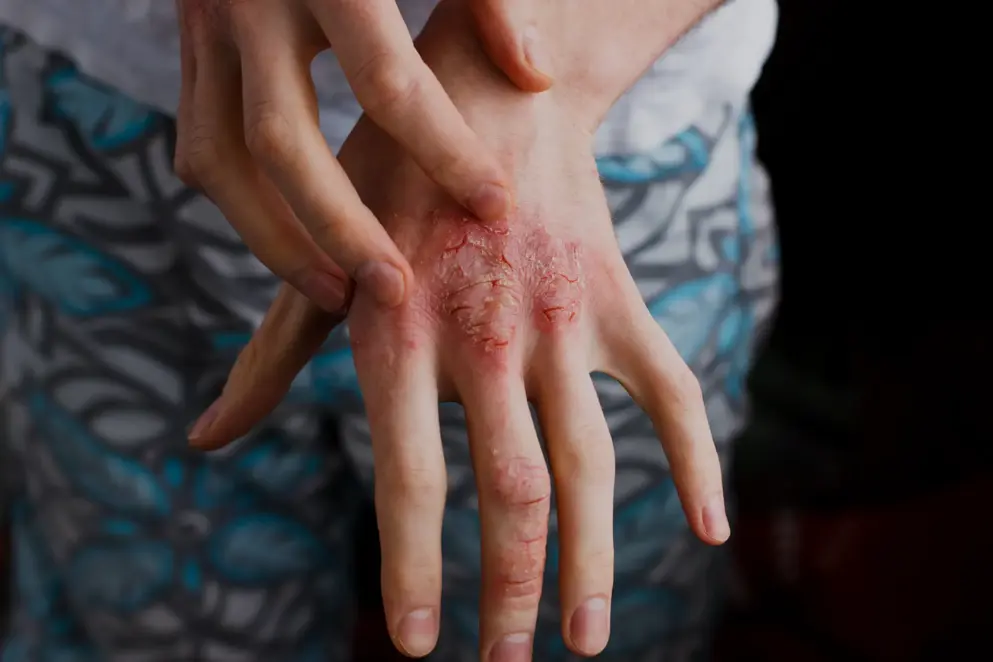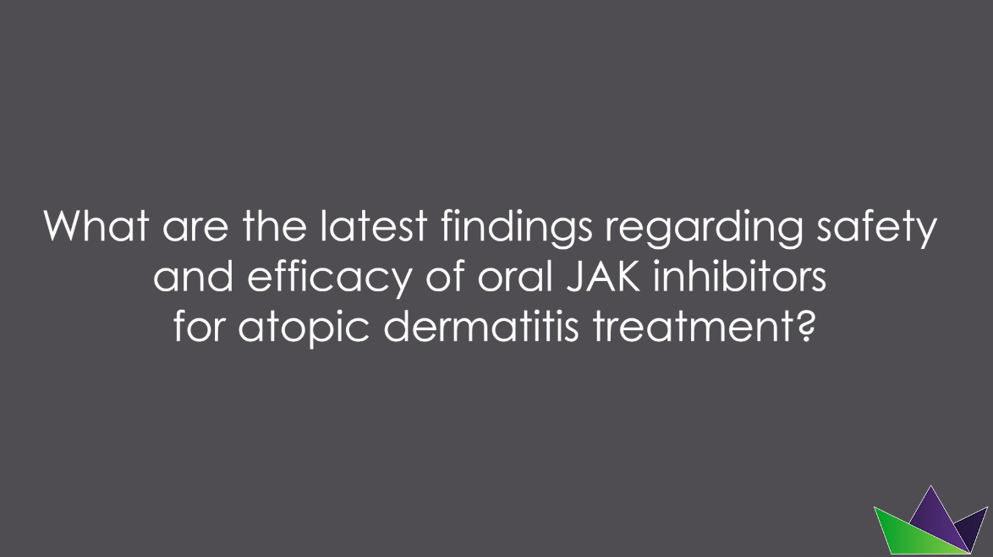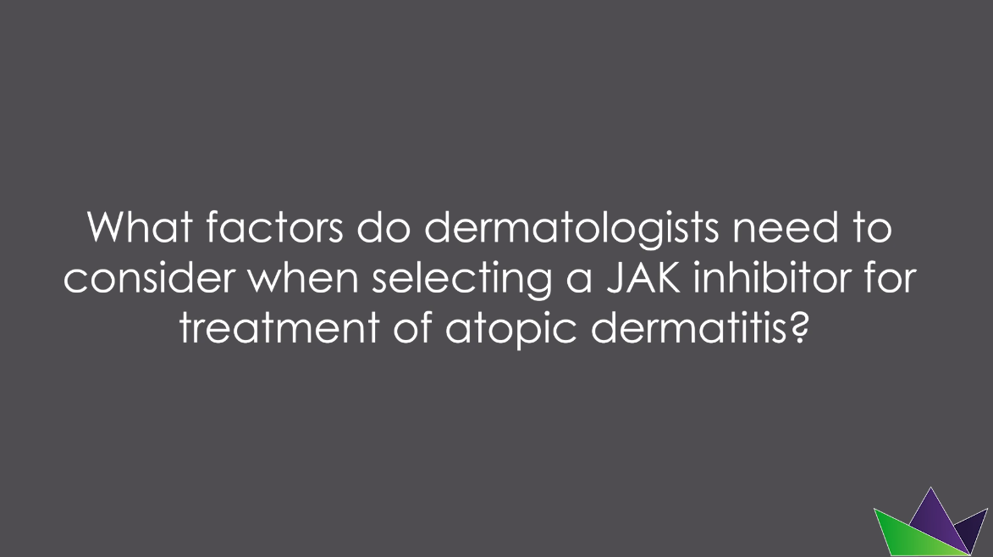
Congress Highlights
American Academy of Dermatology (AAD) 2022 Annual Meeting: Focus on atopic dermatitis
Discover developments in medications to treat atopic dermatitis, presented at AAD 2022:
- Watch “Introduction to the JAK-STAT Pathway”, a video presentation by Dr Brett Andrew King
- View long-term tolerability data on treatments in adolescents with moderate-to-severe atopic dermatitis
- Compare various JAK inhibitors for skin improvement in moderate-to-severe atopic dermatitis
Introduction to updates in JAK Inhibitors for atopic dermatitis
In 2022, the FDA approved two oral Janus kinase (JAK) inhibitors for the treatment of atopic dermatitis (AD): abrocitinib and upadacitinib; and one topical JAK inhibitor, ruxolitinib.
As described by Dr Brett Andrew King, Associate Professor of Dermatology at Yale School of Medicine, such breakthroughs are merely the ‘tip of the iceberg’ in the application of JAK inhibitors in dermatology1.
Updates in the application of JAK inhibitors in atopic dermatitis: exploring efficacy and safety
In our interview “What is the JAK STAT signalling pathway and why is it so relevant in inflammatory skin conditions including AD”, Dr Brett King summarises the importance of the Janus kinase (JAK)-signal transducer and activator of transcription (STAT) pathway to AD pathophysiology.
Other AD relevant presentations included “JAK inhibitors for atopic dermatitis” hosted by Dr Eric Lawrence Simpson, and “Understanding the risks of JAK inhibitors”, hosted by Dr Brett Andrew King.
Award-winning e-posters at AAD 2022: JAK inhibitors for atopic dermatitis
Integrated Analysis of Abrocitinib for the Treatment of Adolescents With Moderate-to-Severe Atopic Dermatitis From the Phase 3 Clinical Trial Program
In a post hoc study, Professor Amy Paller and colleagues analysed the efficacy and safety profile of abrocitinib, in relation to dose (200 mg or 100 mg), with longer-term exposure (~1 year), in adolescents (aged 12–17 years)2.
- Abrocitinib was well-tolerated long-term in adolescents with moderate-to-severe AD
- Adverse events were dose dependent, and similar across doses
- The high rate of efficacy response to abrocitinib, observed in adolescents at 12 weeks, was sustained to Week 48 (Figure 1)
Figure 1. Proportion of adolescents who achieved efficacy response over 48 weeks of abrocitinib2.
Efficacy and safety of abrocitinib according to geographies
This pooled study, led by Professor Andrew F Alexis, assessed the efficacy and safety of abrocitinib for AD across geographic regions (United States, Canada, Australia; Eastern Europe, Russia; Western Europe, Asia), with a focus on patients receiving abrocitinib (200 mg or 100 mg) for moderate-to-severe AD3.
The patients were analysed from two groups of AD trials: monotherapy trials (one phase 2b study4, and two phase 3 studies [JADE MONO-15 and JADEMONO-26); the Phase 3 JADE COMPAREa study (abrocitinib was administrated plus medicated topical therapy7.
- Abrocitinib was efficacious across the evaluated geographic regions in the monotherapy trials and JADE COMPAREa
- Abrocitinib’s safety profile was similar across the geographic areas
- Rates of treatment-emergent adverse events (TEAEs) that led to discontinuation were low across all geographic areas
- TEAE rates were numerically higher in Western European areas, compared to other areas
In relation to the phase III JADE programme, learn more about the efficacy results regarding abrocitinib for AD, from Dr King.
Achieving incrementally greater skin improvement thresholds with upadacitinib vs dupilumab in moderate-to-severe atopic dermatitis: heads up study results
The Phase 3b Heads Up randomised clinical trial compared upadacitinib with dupilumab, a monoclonal antibody that blocks interleukin-4 and interleukin-13, for skin improvement in moderate-to-severe AD8.
- More patients treated for moderate-to severe-AD achieved incrementally greater levels of skin improvement with upadacitinib 30 mg, than with dupilumab 300 mg at Weeks 16 and 24
Learn more about the highlights from AAD, regarding the inhibition of interleukin signalling pathways from Dr King.
Efficacy of ruxolitinib cream for the treatment of atopic dermatitis by anatomic region: pooled analysis from two randomized phase 3 studies
Ruxolitinib cream, a topical formulation of ruxolitinib, is a selective inhibitor of JAK1 and JAK29, 10. In this pooled analysis, data was collated from two, Phase 3 randomised studies (TRuE-AD1 and TRuE-AD2) to analyse the efficacy and safety of ruxolitinib cream by anatomic region and signs of AD11.
- As early as Week 2, ruxolitinib cream (0.75% and 1.5%) showed significant improvements in induration/papulation/edema, erythema, excoriations, and lichenification, across anatomic regions, compared to vehicle
- These improvements were sustained through to Week 8
- Ruxolitinib cream was well tolerated, regardless of lesion location
Learn more about the efficacy and safety profile of ruxolitinib, and how topical and oral treatments compare in AD in this video from Dr King.
Explore further highlights from AAD in these additional videos from Dr King, regarding oral JAK inhibitors, dermatologist’s decisions when using JAK inhibitors and advice for dermatologists when discussing treatment options with patients.
References
- Intelligence P. 2022 American Academy of Dermatology Annual Meeting. 2022. Available at: https://pharmaintelligence.informa.com/.
- Paller A, Eichenfield, L., Cork, M., Bangert, C., Irvine, A., Weidinger, W. Integrated Analysis of Abrocitinib for the Treatment of Adolescents with Moderate-to-Severe Atopic Dermatitis From the Phase 3 Clinical Trial Program. Presented at the American Association of Dermatology Annual Meeting 2022, 26 March. Boston. ID 34655. Available at: https://eposters.aad.org/abstracts/34655.
- Alexis AF, Rice, Z.P., Kabashima, K., Luna, P.C., Thyssen, J.P., Trzeciak, M. Efficacy and Safety of Abrocitinib According to Geographies. Presented at the American Association of Dermatology Annual Meeting 2022, 26 March. Boston. ID 32496. Available at: https://eposters.aad.org/abstracts/32496.
- Gooderham MJ, Forman, S. B., Bissonnette, R., Beebe, J. S., Zhang, W., Banfield, C., Zhu, L., Papacharalambous, J., Vincent, M. S., & Peeva, E. (n.d.). Efficacy and Safety of Oral Janus Kinase 1 Inhibitor Abrocitinib for Patients With Atopic Dermatitis A Phase 2 Randomized Clinical Trial. JAMA Dermatol. 2019;155(12):1371-1379.
- Simpson EL, Sinclair, R., Forman, S., Wollenberg, A., Aschoff, R., Cork, M., Bieber, T., Thyssen, J. P., Yosipovitch, G., Flohr, C., Magnolo, N., Maari, C., Feeney, C., Biswas, P., Tatulych, S., Valdez, H., & Rojo, R. Efficacy and safety of abrocitinib in adults and adolescents with moderate-to-severe atopic dermatitis (JADE MONO-1): a multicentre, double-blind, randomised, placebo-controlled, phase 3 trial. The Lancet. 2020;396(10246):255–266.
- Silverberg JI, Simpson, E. L., Thyssen, J. P., Gooderham, M., Chan, G., Feeney, C., Biswas, P., Valdez, H., DiBonaventura, M., Nduaka, C., & Rojo, R. Efficacy and Safety of Abrocitinib in Patients With Moderate-to-Severe Atopic Dermatitis A Randomized Clinical Trial Supplemental content. JAMA Dermato. 2020;156(8):863–873.
- Bieber T, Simpson, E. L., Silverberg, J. I., Thaçi, D., Paul, C., Pink, A. E., Kataoka, Y., Chu, C.-Y., DiBonaventura, M., Rojo, R., Antinew, J., Ionita, I., Sinclair, R., Forman, S., Zdybski, J., Biswas, P., Malhotra, B., Zhang, F., & Valdez, H. Abrocitinib versus Placebo or Dupilumab for Atopic Dermatitis. New England Journal of Medicine. 2021;384(12):1101–1112.
- Silverberg JI, Eyerich K, de Bruin-Weller M, Calimlim BM, Platt AM, Wu T, et al. Achieving Incrementally Greater Skin Improvement Thresholds with Upadacitinib vs Dupilumab in Moderate-to-Severe Atopic Dermatitis: Heads Up Study Results. Presented at the American Association of Dermatology Annual Meeting 2022, 26 March. Boston, Massachusetts. Poster ID: 34599. Available at: https://eposters.aad.org/abstracts/34599. Accessed 8 April 2022.
- Papp K, Szepietowski JC, Kircik L, Toth D, Eichenfield LF, Leung DYM, et al. Efficacy and safety of ruxolitinib cream for the treatment of atopic dermatitis: Results from 2 phase 3, randomized, double-blind studies. J Am Acad Dermatol. 2021;85(4):863-872.
- Quintá S-Cardama A, Vaddi, K., Liu, P., Manshouri, T., Li, J., Scherle, P. A., Caulder, E., Wen, X., Li, Y., Waeltz, P., Rupar, M., Burn, T., Lo, Y., Kelley, J., Covington, M., Shepard, S., Rodgers, J. D., Haley, P., Kantarjian, H., Fridman, J. S., Verstovsek, S. Preclinical characterization of the selective JAK1/2 inhibitor INCB018424: therapeutic implications for the treatment of myeloproliferative neoplasms. Blood. 2010;115(15):3109-3117.
- Simpson E, Bissonnette R, Stein Gold L, Fuxench Z, Venturanza M, Ren H, et al. Efficacy of ruxolitinib cream for the treatment of atopic dermatitis by anatomic region: pooled analysis from two randomized phase 3 studies. Presented at the American Association of Dermatology Annual Meeting 2022, 26 March. Boston, Massachusetts. ID 34587. Available at: https://eposters.aad.org/abstracts/34587. Accessed 28 March 2022.
of interest
are looking at
saved
next event
This content has been developed by Medthority who previously received funding in order to help provide its healthcare professional members with access to the highest quality medical and scientific information, education and associated relevant content.



